Antique Clocks
-
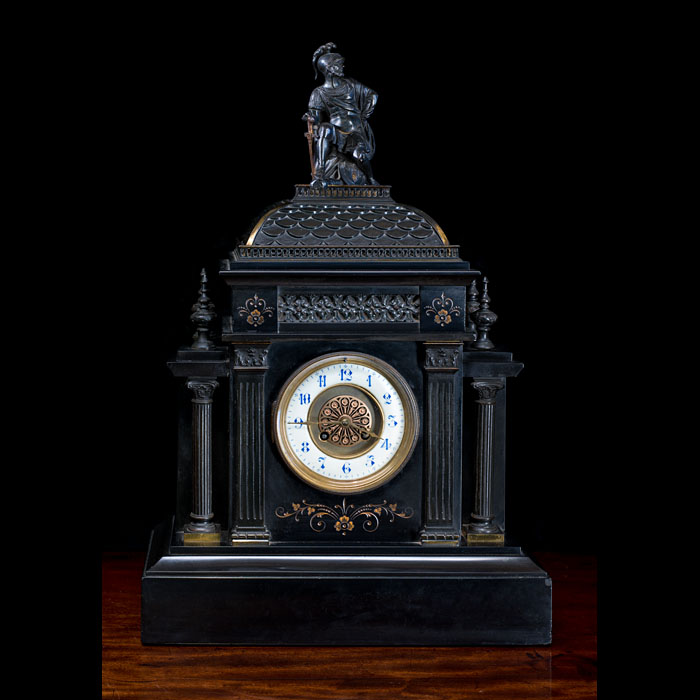 Sold
Sold
Stock: 15758
A large and imposing Victorian Belgian black marble and bronze mantel clock of architectural form. The case is surmounted by a bronze figure of a Roman Centurion who sits on a roof of fishscale tiles. The rest of the case is carved from Belgian black marble and is modelled as an architectural facade, with both corinthian pilasters and columns framing the dial. Behind the glass door, the dial is enameled with blue Arabic numerals. Inside, there is a fine eight day French movement that strikes the hours and the half-hour hours on a single gong.
English, c.1880.
View our collection of: Antique clocks and clock garniture
|
Width |
Height |
Depth |
|
14 3⁄8"
36.5 cms |
21 11⁄16"
55 cms |
6 11⁄16"
17 cms |
|
|
|
|
-
 Sold
Sold
Stock: 15572
A fine and large nineteenth-century Gothic Revival oak bracket clock, with a silvered dial.
The clock has an eight day, triple fusee, four pillar movement with anchor escapement and chimes the quarters on either eight or four bells, "Westminster chimes" and strikes the hours on a single gong.
The finely engraved silvered arched top brass dial with Roman numerals has three subsidiary dials, namely; strike or silent, slow or fast, Westminster chime, or chime on 8 bells. Engraved spandrels frame the chapter ring.
The case is the perfect incarnation of the Gothic Revival, the cathedral case topped with spires and finials which are supported by cluster pilasters whilst the dial is framed with a foliate ogee window.
English, circa 1850.
View our collection of: Antique clocks and clock garniture
|
Width |
Height |
Depth |
|
16 1⁄2"
42 cms |
26"
66 cms |
9 3⁄8"
24 cms |
|
|
|
|
-
 Sold
Sold
Stock: 15517
A fine mid-nineteenth century eight-day longcase clock by W.J. Frodsham of Change Alley, London within a mahogany and marquetry case.
The eight day, triple train, four pillar movement with anchor escapement, chimes the quarters on either eight or four bells, "Westminster chimes" and strikes the hours on a single gong. The 12 inch arched top brass dial with strike / silent lever and four bell chime / eight bell chime lever, has a silvered chapter ring with gilt brass putti and crown spandrels, beneath an oval cartouche engraved with the maker, W.J.Frodsham, Change Alley, London.
The fine marquetry - almost Rococo in design - depicts two lovers walking within a pastoral scene, and is framed by foliate scrolls and floral sprays.
English, circa 1840.
Notes:
The first recorded clockmaker by the name Frodsham was a William Frodsham, born in 1728 and is believed to have worked as a Journeyman for Justin Vulliamy, who was clockmaker to George III.
In the early 19th century, the family were established as clockmakers, and entered a partnership with the well-regarded chronometer makers, the Parkinson’s and the business became Parkinson & Frodsham of 4 Change Alley. After the death of William Parkinson, the firm became W J Frodsham’s in 1842, until he handed the business over to his sons in 1847 the year that those sons were admitted to the Clockmakers’ Company. In subsequent years, the Frodshams exhibited at the Paris Exhibition of 1867 and 1889, developing and international reputation for quality.
Condition notes: A very slight warp to the bottom of the trunk door.
|
width |
height |
depth |
|
20 1⁄2"
52 cms |
95 1⁄2"
242.5 cms |
10 5⁄8"
27 cms |
|
|
|
|
-
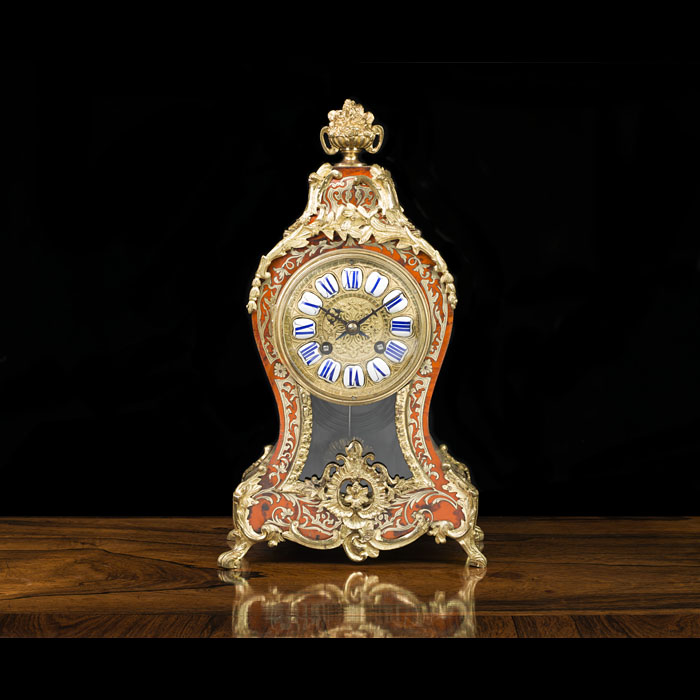 Sold
Sold
Stock: 15753
A fine 19th century French boulle red tortoiseshell mantel clock with brass boulle inlay in the Rococo style. The ormolu case mounts are surmounted by an urn finial and the ormolu dial is mounted with enamel numerals and blued steel hands. The movement is a two trained striking movement and is stamped A&N.
French, late 19th century.
Notes:
Boulle work is an inlay process that was developed by the French Cabinet maker to the crown, André Charles Boulle (1642-1732). It involves veneering objects with tortoiseshell and inlaying this surface with gilt brass, brass or pewter in elaborate designs.
View our collection of: Antique clocks and clock garniture
|
Width |
Height |
Depth |
|
7 1⁄2"
19 cms |
13"
33 cms |
4 1⁄4"
11 cms |
|
|
|
|
-
 Sold
Sold
Stock: 15508
A good example of an early twentieth century time recorder clock in an oak case, serial number 51947. The glass door panel bears the words, "National Time Recorder Co. (Patentees) Blackfriars London. S.E.". The clock face with Roman numerals is set within a wood frame and bears the name "National Time Recorder Co. Ltd. Aquinas St, Stamford St. London EC1". beneath which is a small metal plaque stating "Local service, The National Time Recorder Co Ltd. Phone: Central 3655 . This Time Recorder is in full working order.
English, circa 1935.
Notes: Time Recorders like this one would have been used to record the times workers came in and out of their place of work. The National Time Recorder Co. Ltd (incorporated in 1917, company number 146424, though possibly founded around 10 years earlier in 1907) was one of the two largest UK manufacturers of time recorders. The head office and factory was originally based in Blackfriars London, and moved to the Lagoon Works in St Mary Cray (Orpington) Kent in 1951, on the site of the Blue Lagoon swimming pool which had been damaged during the war. Other branches were established in London, Birmingham, Bristol, Dublin, Glasgow, Leeds, Manchester, Newcastle-upon-Tyne and Sheffield. [Source: World Clocks]
|
Width |
Height |
Depth |
|
12 1⁄2"
31.8 cms |
42"
106.7 cms |
11"
28 cms |
|
|
|
|
-
 Sold
Sold
Stock: 15459
A fine oak longcase clock by Philip Avenell of Farnham with later lacquered chinoiserie decoration. The eight day movement strikes the hours on a clear bell. The clock face has a 12 inch brass break arched brass dial flanked by ornate gilt brass spandrels. The raised silvered chapter ring is crisply engraved with black Roman numerals and Arabic five minute numerals to the outer aspect. The central dial has a subsidiary seconds dial, a date aperture and is profusely engraved with floral decoration. The maker's signature is signed within a cartouche. The chinoiserie decoration was likely added in the early twentieth-century. English, c.1780
Notes: Philip Avenell was part of a 200 year dynasty of clockmakers based in the South of England. Watchmakers and clockmakers of the world’ by Brian Loomes records Phillip Avenell as working in London circa 1765 then in Farnham from circa 1775, roughly when this clock was made. Philip Avenell died in 1809.
|
Width |
Height |
Depth |
|
18 1⁄4"
46.5 cms |
86 5⁄8"
220 cms |
10"
25.5 cms |
|
|
|
|
-
 Sold
Sold
Stock: 15456
A very fine mahogany longcase clock, with an eight day movement by John Wyld of Nottingham. The fine silver dial is centred by a painted scene of a wooded landscape and this frames a date aperture. The lunette above is adorned with not only a painted moondial, but with opposing hemispheres. The dial is framed by very fine brass cherub spandrels, and mounted with three pierced hands.
The hood of the clock has a swan necked pediment with trompe l'oeil marquetry and a brass finial, which is echoes in the pair of fluted corinthian columns with brass capitals.
Inside the figured case is a four pillar movement which will be fully serviced on purchase.
Notes on the maker: John Wyld was an important and very competent maker who was born in Codnor, Derbyshire in 1710, son of another John Wyld (1678-1760) by Rebecca, sister of the notable Codnor clockmaker James Woolley (1695-1785), to whom Wyld was apprenticed. He set up at Codnor around 1732 and also rented a workshop in Chapel Bar in Nottingham from a Mr. Lupton shortly afterwards. He married in 1740 and died in 1773 leaving John, his successor at Nottingham, Joseph and three daughters.
Link to: Antique clocks and clock garniture
|
width |
height |
depth |
|
21 11⁄16"
55 cms |
96 7⁄8"
246 cms |
10 5⁄8"
27 cms |
|
|
|
|
-
 Sold
Sold
Stock: 15460
A George III 30 hour oak longcase clock with an engraved silvered dial and Roman numerals, framed by gilt spandrels to the corners. To the centre of the dial is a date aperture, and also an arched moondial with hand painted decoration. This elegant dial sits within a columned hood of an elegantly simple design. It has a 4 pillar movement. This clock will be serviced upon purchase.
Signed: Samuel Butterworth of Rochdale.
English, c.1770.
|
width |
height |
depth |
|
79"
200.6 cms |
23"
58.4 cms |
|
|
|
|
|
-
 Sold
Sold
Stock: 15452
A fine example of an early twentieth century time recorder clock in an oak case. The bevelled glass panel bears the words 'Manufactured By The National Time Recorder Co. (Patentees) London SE.' The clock face with Roman numerals is set within a carved wood frame and bears the name British Time Recorder Co. Ltd. 149 Farringdon Road, London EC. beneath which is a small metal plaque stating 'Overhauled by British Time Recorder Co. Ltd, 149 Farringdon Road, London EC1 Phone. Terminus 1451 and the Reg No 8129'. This Time Recorder is in full working order.
English, circa 1912.
Notes: Time Recorders like this one would have been used to record the times workers came in and out of their place of work. The National Time Recorder Co. Ltd (incorporated in 1917, company number 146424, though possibly founded around 10 years earlier in 1907) was one of the two largest UK manufacturers of time recorders in the UK. The head office and factory was originally based in Blackfriars London, and moved to the Lagoon Works in St Mary Cray (Orpington) Kent in 1951, on the site of the Blue Lagoon swimming pool which had been damaged during the war. Other branches were established in London, Birmingham, Bristol, Dublin, Glasgow, Leeds, Manchester, Newcastle-upon-Tyne and Sheffield.
.
|
Width |
Height |
Depth |
|
15 7⁄8"
40.3 cms |
47"
119.5 cms |
11"
28 cms |
|
|
|
|
-
 Sold
Sold
Stock: 14688
An interesting 19th century Belgian Black Marble and patinated bronze mounted mantel clock. The clock face rests on the back of a large bronze grotesque which holds the brass rimmed black dial with its brass Roman numerals and hands which are fixed to an engraved sunburst plate. This is flanked on either side with classical style relief panels in patinated bronze and the arched top is supported by a pair Atlas styled crouching figures in the manner of Alfred Stevens. The movement strikes on a gong and the whole is raised on a plinth base with brass stepped feet.
French circa 1875.
Link to: Antique clocks and clock garniture
|
width |
height |
|
|
22 3⁄8"
57 cms |
9 3⁄8"
24 cms |
|
|
|
|
|
-
 Sold
Sold
Stock: 14968
An impressive and large late 19th century French quarter chiming gilt brass Gothic
Revival bracket or mantel clock retailed by Hall & Company, Manchester. The case, with engraved floral decoration and applied coloured cabuchon jewel mounts, encloses a gilt 7" Roman dial with a finely scroll engraved centre and an eight day spring driven movement with anchor escapement chiming the quarters on a nest of two bells. The movement was made in Saint Nicolas d' Aliermont, by Pierre-Honoré-César Pons and then finished by the Parisian Clock maker, Louis Achille Brocot. French, circa 1870.
Link to: Antique clocks and clock garniture
|
width |
height |
depth |
|
16 7⁄8"
43 cms |
31 1⁄2"
80 cms |
12 3⁄16"
31 cms |
|
|
|
|
-
 Sold
Sold
Stock: 14308
A gilt bronze highly elaborate, twin train striking mantel clock garniture in the Rococo style embellished throughout with acanthus scrolls and swags, urns, acorn finials and applied leaf detail echoed on the twin five branch candelabra.
The enamel clock face has fine cobalt blue Roman hours and black Arabic minutes with elaborate pierced
and engraved gilt hands. Movement by Bonnard, Dijon.
French mid 19th century.
Link to: Antique clocks and clock garniture
|
Width |
Height |
Depth |
| Clock |
18 1⁄8"
46 cms |
18 1⁄4"
46.5 cms |
4 7⁄8"
12.5 cms |
| Candelabras |
10 3⁄8"
26.5 cms |
19 11⁄16"
50 cms |
|
-
 Sold
Sold
Stock: 14142
A very fine large Louis XVI style three piece clock garniture.
French, late 19th century.
Link to: Antique clocks and clock garniture
|
Width |
Height |
Depth |
| Clock |
14 3⁄8"
36.5 cms |
28 1⁄4"
72 cms |
10 3⁄16"
26 cms |
| Candelabras |
15 3⁄8"
39 cms |
28 11⁄16"
73 cms |
|
-
 Sold
Sold
Stock: 13733
A large and very fine late 19th century Belgian Louis XVI style ormolu and Rosso
Alicante marble three piece striking clock garniture.
The clock has a large ornate draped urn finial, and is flanked by lion masks with ring handle, the enamel dial, enscribed Bronzes/Compagnie Anonyme/ A Bruxelles with Roman hours and Arabic five minutes. The clock is supported on a scroll mounted and festooned architectural plinth
The garniture consists of a pair of large ormolu and Rosso Alicante marble candelabra, each having seven delicate & graceful arms hung with cut crystal glass drops supported on further drapped urns, with pairs of lion masks on either side, above ormolu mounted architectural plinths.
Late 19th century and made by the Compagnia Anonyme, Brussels.
Link to: Antique clocks and clock garniture
|
width clock & candelabra |
height clock & candelabra |
depth clock |
|
14 5⁄8"
37 cms |
28 11⁄16"
73 cms |
10 3⁄16"
26 cms |
|
13 3⁄8"
34 cms |
29 7⁄8"
76 cms |
|
-
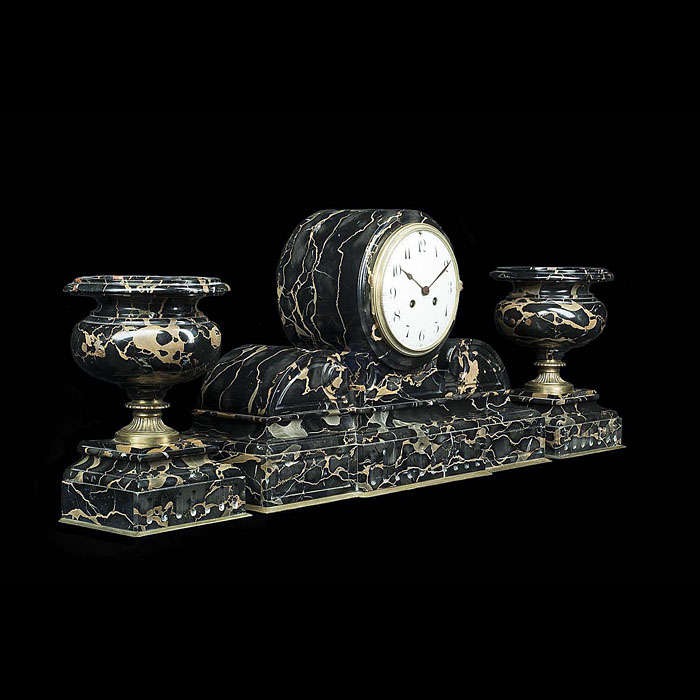 Sold
Sold
Stock: 13555
A Neoclassical style mantelpiece clock in black and gold Portoro marble with brass detail paired with twin urn vases. The simple white enameled clock face with Arabic numerals, the whole resting on a stepped fluted base.
French circa 1870.
Link to: Antique clocks and clock garniture
|
Width |
Height |
Depth |
| clock |
21 1⁄8"
53.5 cms |
12 13⁄16"
32.5 cms |
6 1⁄2"
16.5 cms |
| urns |
6 3⁄8"
16.2 cms |
9 13⁄16"
25 cms |
|
-
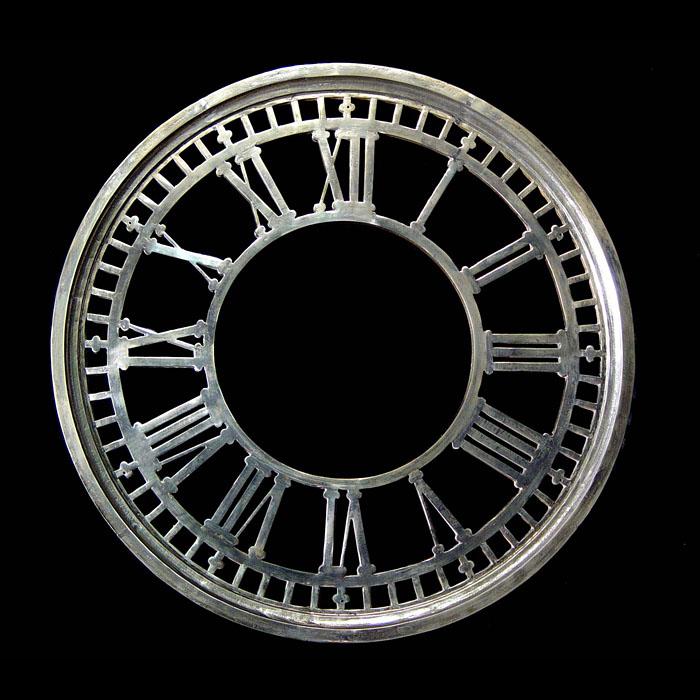 Sold
Sold
Stock: 8477
A Victorian cast iron clock chapter ring.
Provenance: Worthington Factory, Macclesfield, the building destroyed by fire in 1999.
Link to: Antique clocks and clock garniture
-
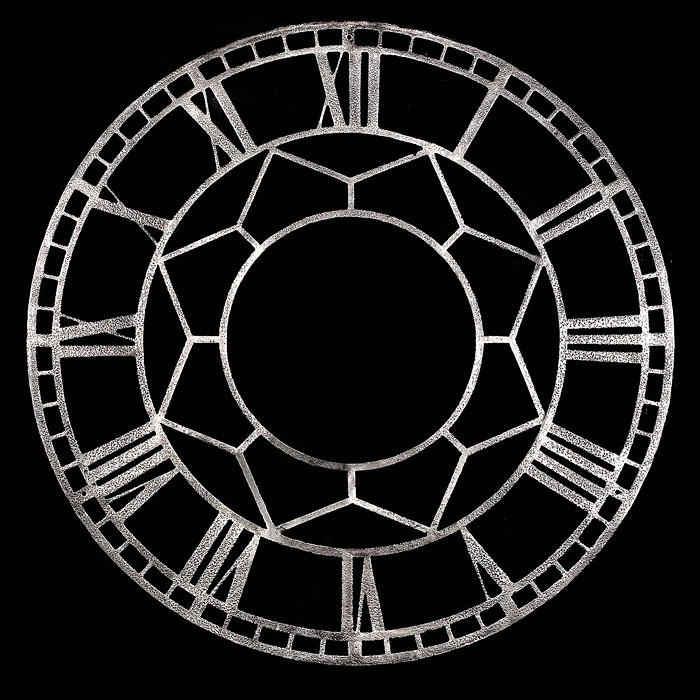 Sold
Sold
Stock: 8064
A pair of cast-iron turret clock dials of openwork design with Roman numerals.
Link to: Antique clocks and clock garniture
|
|
|
|
| DIAMETER |
50 1⁄2"
128.3 cms |
|
|
|
|
|
|
-
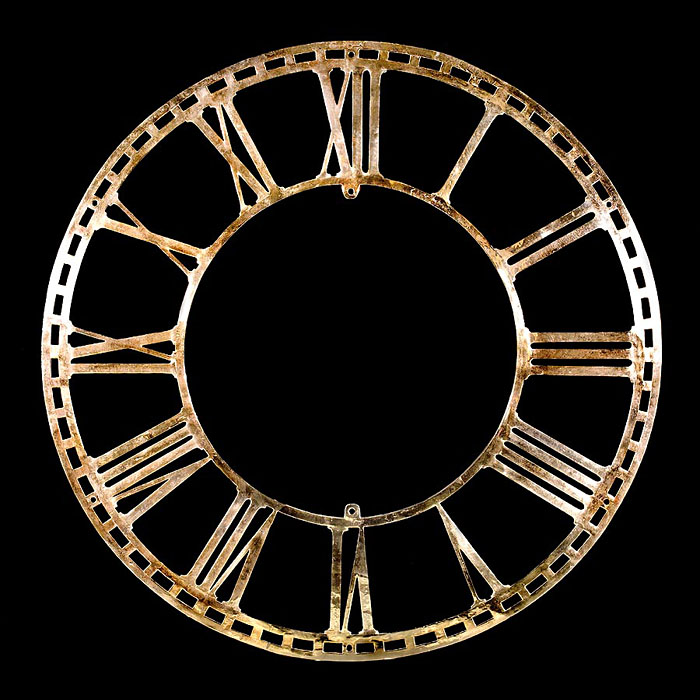 Sold
Sold
Stock: 7949
A pair of burnished bronze chapter rings (clock faces) with Roman numerals.
Scottish, circa 1850.
Link to: Antique clocks and clock garniture
|
diameter |
depth |
|
| external |
69"
175.3 cms |
1"
2.5 cms |
|
|
|
|
|
-
 Sold
Sold
Stock: 4265
A fine, large mantel clock with a bronzed figure of King Arthur on a Belgian black marble plinth.
French, 19th century, circa 1860.
Link to: Antique clocks and clock garniture
|
width |
height |
depth |
| external |
24 1⁄2"
62.2 cms |
28 1⁄4"
71.8 cms |
11 1⁄4"
28.6 cms |
| internal |
|
|
|
-
 Sold
Sold
Stock: 4077
A fine bronze and Sienna marble mantel clock, the gilt dial with inner cast ring depicting signs of the zodiac and central star, the bell striking movement with outside countwheel and silk suspensio. Signed on the back plate - Charles, Rue St. Honore, No.272, the case surmounted by a classical female figure with a marble ball and three books.
French, Louis Phillipe, 19th century, circa 1840.
Link to: Antique clocks and clock garniture
|
WIDTH |
HEIGHT |
DEPTH |
|
17 13⁄16"
45.1 cms |
23 11⁄16"
60.3 cms |
6 1⁄4"
15.9 cms |
|
|
|
|
-
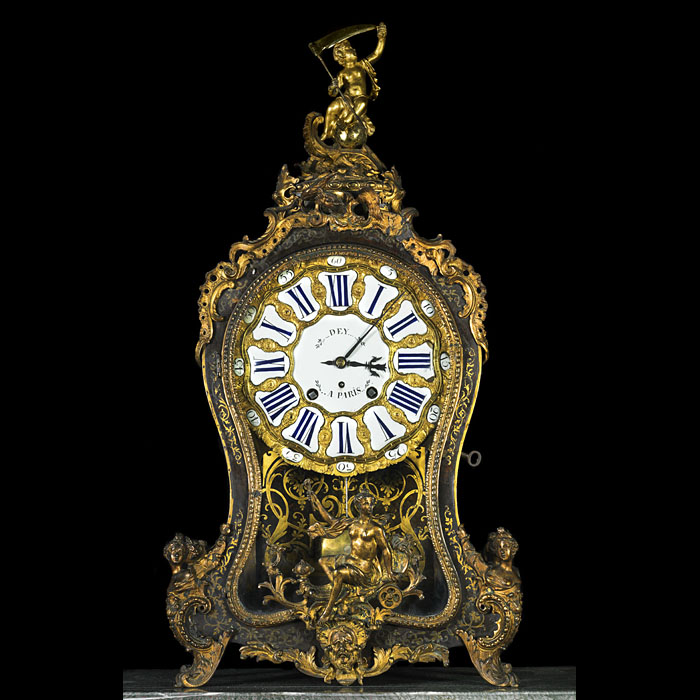 Sold
Sold
Stock: 4012
A fine 18th century Louis XV Boulle cartel clock with gilt-bronze mounts, the enamel and gilt bronze dial signed Dey a Paris, the glazed door with Flora, Goddess of Flowers and the waisted case with a putto finial with scrolling figureheads.Unrestored but in working order.
Link to: Antique mirrors, matching console tables
|
WIDTH |
HEIGHT |
DEPTH |
| CLOCK |
18"
45.7 cms |
35"
88.9 cms |
6 1⁄2"
16.5 cms |
| BRACKET |
22"
55.9 cms |
17 1⁄2"
44.4 cms |
|
Antique clocks not only showcase timeless elegance but also quality craftsmanship. They come in many forms, from the imposing and grandest of longcase clocks, to the exquisite beauty of a carriage clock. They can, therefore, find a place in almost any interior, and the comforting sound of their ticking and striking becomes the heartbeat of a home.
Antique mantel clocks were made to sit above a fireplace, they command attention in one of the post prominent positions in the home. For this reason, they are often very ornamental, using fine woods and metals that exude quality.
An antique clock garniture makes even more of a statement, as it comprises not only an antique mantel clock but also a pair of candelabra or urns, intended to sit either side of the clock. This became very popular in the 19th century when the mantelpiece was often displayed with collectible porcelain and objets d’art. Today, a clock garniture can either be displayed together on a mantelpiece or a table, or even separated, so the candelabra might be used on a dining table whilst the clock remains in place.
Antique French clocks are often accompanied by a garniture and are made from gilt bronze. Their movements exude quality and are often finer than their English counterparts.
The longcase clock is most domineering of all, standing taller than the inhabitants of the home and commanding attention with its authoritative ticking and striking. These large, magnificent clocks were made in many different woods, and some are even lacquered. Chinoiserie longcase clocks are delicately decorated with Chinese inspired designs, and emerged in the 18th century, when there was a huge surge in interest for East Asian artworks.
To be an antique clock dealer, understanding the workings of antique clocks, and their sometimes-temperamental nature, is important. Here at Westland London, we have a dedicated restoration department with experience in all areas of clock restoration.
An antique clock face is without doubt a more evocative sight than the bright lights of its digital successor, and we hope our selection of antique clocks will inspire you to have one in your home.